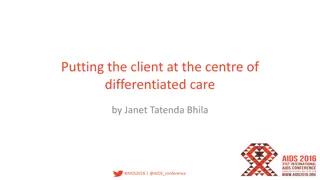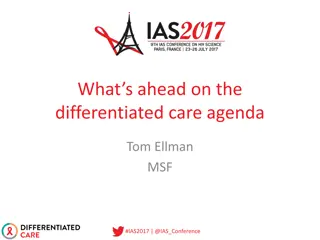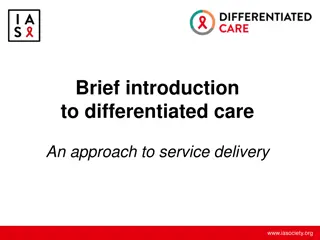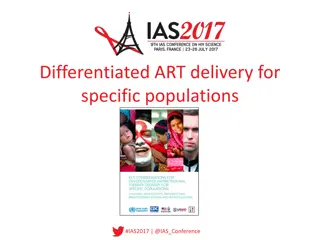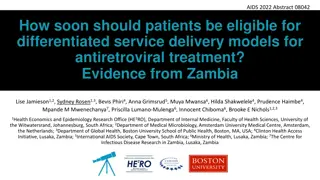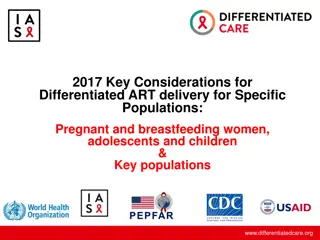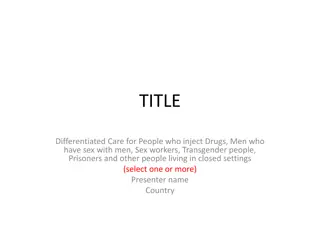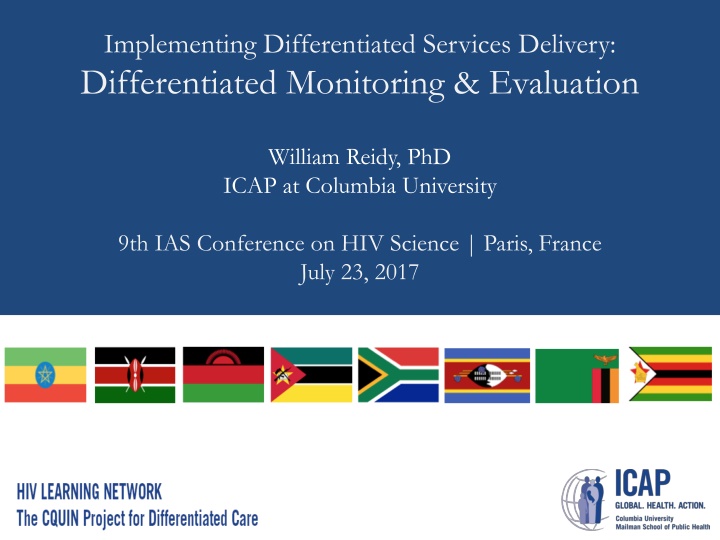
Implementing Differentiated Services Delivery Monitoring & Evaluation
Explore the challenges and solutions in monitoring and evaluating differentiated service delivery models for HIV programs. Learn about the need for tailored monitoring systems, data collection in the community, harmonizing M&E systems, and updating data elements. Discover the mismatch between existing indicators and DSD models, the proliferation of parallel M&E systems, and the rationale for integrated M&E approaches.
Download Presentation

Please find below an Image/Link to download the presentation.
The content on the website is provided AS IS for your information and personal use only. It may not be sold, licensed, or shared on other websites without obtaining consent from the author. If you encounter any issues during the download, it is possible that the publisher has removed the file from their server.
You are allowed to download the files provided on this website for personal or commercial use, subject to the condition that they are used lawfully. All files are the property of their respective owners.
The content on the website is provided AS IS for your information and personal use only. It may not be sold, licensed, or shared on other websites without obtaining consent from the author.
E N D
Presentation Transcript
Implementing Differentiated Services Delivery: Differentiated Monitoring & Evaluation William Reidy, PhD ICAP at Columbia University 9th IAS Conference on HIV Science | Paris, France July 23, 2017
Background/Context Countries are rapidly adopting diverse differentiated service delivery models (DSDM) eligibility criteria and DSD models vary Monitoring and evaluation systems (tools, reporting, databases) are often not tailored to these new models New data elements may be needed Some current data no longer applicable at visits Data may be collected in the community, by patients Flexible DSDM vs. standardized M&E CQUIN: The HIV Learning Network
Outline The challenges: Changes in program design associated with DSDM may cause problems for existing M&E systems Existing M&E systems may not capture the information needed to monitor and evaluate DSDM The solution: Differentiated M&E? Harmonizing and streamlining systems Updating patient and program level data Performance assessment CQUIN: The HIV Learning Network
Mismatch between Existing Indicators and Some DSD Models Retention on ART by Month from ART Initiation 24-month retention on ART (optional) 36-month retention on ART (optional) ART Initiation 12-month retention on ART First eligible for DSD models* 12-month retention on DSD model 24-month retention on DSD model Retention on DSD Model by Month from ART Initiation * timing of eligibility differs based on model CQUIN: The HIV Learning Network
Parallel M&E Systems are Proliferating ART medical record Standard indicators and reports 1. Traditional M&E ART register 2. DSDM M&E CAG data CAG register CAG reports CQUIN: The HIV Learning Network
Rationale for integrated M&E As ART models diversify and additional patients move to DSD models, ensure information is accessible to HCW Clinic-based ART CAG Fast-track Community pick up CQUIN: The HIV Learning Network
Documentation is Insufficiently Streamlined Standard ART visit: Weight / height WHO stage Pregnancy OIs TB status and treatment IPT Adherence Side effects Lab test & results ART refill Next appointment date Fast-track visit: TB screening ART refill CAG visit : Adherence self-assessment TB screening self assessment ART refill CQUIN: The HIV Learning Network
Outline The challenges: Changes in program design associated with DSDM may cause problems for existing M&E systems Existing M&E systems may not capture the information needed to monitor and evaluate DSDM The solution: Differentiated M&E? Harmonizing and streamlining systems Updating patient and rogram level data Performance assessment CQUIN: The HIV Learning Network
Illustrative DSDM Treatment Indicators UPTAKE percentage of newly eligible patients receiving DSDM COVERAGE percentage of sites offering DSDM percentage of all eligible patients receiving DSDM QUALITY & OUTCOMES percentage of patients retained percentage maintaining DSDM percentage receiving VL test percentage suppressed CQUIN: The HIV Learning Network
Outline The challenges: Changes in program design associated with DSDM may cause problems for existing M&E systems Existing M&E systems may not capture the information needed to monitor and evaluate DSDM The solution: Differentiated M&E? Harmonizing and streamlining systems Updating patient and program level data Program assessment CQUIN: The HIV Learning Network
Integrated M&E Systems Incorporate all information into one record (paper or electronic) updated Standard indicators / reports reports All CAG register ART medical record record ART medical 1. Mainstream HIV care & tx M&E Integrated HIV care & tx M&E indicators / ART register 2. DSD model M&E CAG data CAG register CAG reports CQUIN: The HIV Learning Network
Integrated M&E Systems Incorporate all information into one record (paper or electronic) updated Standard indicators / reports reports All CAG register ART medical record Integrated HIV care & tx M&E indicators / ART patient- level database CAG data CQUIN: The HIV Learning Network
Patient-Level Tools to Document DSD 1. Adapted patient ART medical record 2. Adapted pharmacy tools and systems 3. New tools to document DSD services CQUIN: The HIV Learning Network
Updating Patient ART Medical Record: Is the patient eligible for specific DSD models? Eligible Not eligible In DSDM Not in DSDM DSD Model: _________ Source: Kenya MOH CQUIN: The HIV Learning Network
New Tools Documentation of services in community Patient self assessments recorded: TB screening Last menstrual period Adherence and pill count (Source: Swaziland MOH) ART distributed
New Tools: Registries of CAG/club patients Clinic register of patients in CAGs (Source: MSF) CQUIN: The HIV Learning Network
Program-Level Tools to Document DSD 1. Identify program-level indicators 2. New systems for aggregation CQUIN: The HIV Learning Network
Illustrative DSD performance indicator cascade Cohort of patients newly-eligible for DSD Additional 12 mo. outcomes: # In care, maintains DSD model classification # In care, switched to entirely clinic-based ART # Lost to follow-up or stopped ART # Dead # newly classified as eligible for DSD model # initiating DSD model # received a VL test at 12 mos. # virally suppressed at 12 mos. CQUIN: The HIV Learning Network
Tools and Systems to Generate Aggregate Reports for DSD Standard ART registers cannot calculate DSD indicator cascade Eligibility classification, DSD model, and services not documented Timeframe oriented around ART initiation New systems for aggregation of relevant data may be necessary Electronic database systems Paper-based tools: DSD ART registers, facility reports CQUIN: The HIV Learning Network
Measuring Impact Measuring Performance of DSDM Evaluations of impact of DSD model on patient outcomes Plan ahead to ensure necessary routine data will be available Periodic assessments of facility adoption of DSD Surveys of patient and provider satisfaction Provider-patient load and productivity Cost-effectiveness CQUIN: The HIV Learning Network
Summary DSDM may require changes to M&E systems M&E systems should be tailored to context Patient-level tools and methods for aggregation may need to be adapted DSDM may be monitored using a unique cascade of indicators The ART medical record is the optimal home of all patient-related information Plan ahead; measure performance of DSDM using various approaches CQUIN: The HIV Learning Network
Additional Resources Learn more about ICAP s CQUIN learning network for differentiated service delivery at: cquin.icap.columbia.edu Download the ICAP Approach to DSD at: bit.ly/ICAPDSD
Acknowledgements Bill & Melinda Gates Foundation Swaziland Ministry of Health Kenya Ministry of Health ICAP colleagues Other CQUIN members who provided input on our approach CQUIN: The HIV Learning Network


